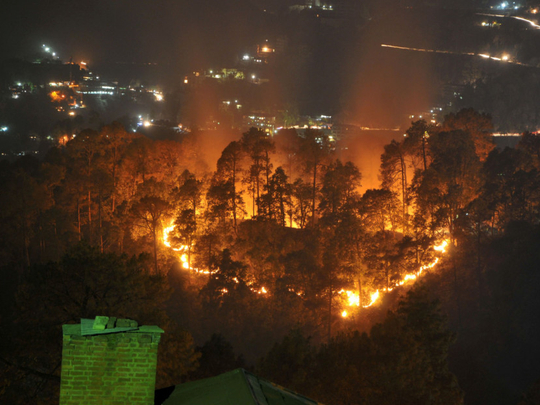
Even as a major forest fire has been raging in the Indian state of Uttarakhand for the last three months, Indian policy-makers and the national media were busy discussing the odd-even scheme in New Delhi, which they believe is the panacea to clean the polluted air of the national capital, while completely ignoring the ecological devastation that was happening few hundred kilometres away.
Social media in India has certainly gained in importance over the years. People in India are getting prompt response from the government by twitting rather than sending in good-old request for help. Here also the government and the media woke up to the ecological disaster only when dramatic pictures of the fire engulfing hundreds of hectares of forest land went viral. Reporters from television and print media were soon sent out to cover the fire, but as usual, Indian media yet again missed the woods for the trees.
The government finally woke up and even deployed personnel and equipment from the Indian Air Force to douse the fire that has so far claimed five lives. The Indian media, now well-known for its hysterics, went on to blame the locals and even the so-called timber merchants, land grabbers and poachers for the same, while ignoring the environmental reasons behind the fire and its long-term effects on the climate.
The media is known to latch on to a particular word, while covering an event, and soon that word becomes the buzzword across all television channels and even in the print media. In case of forest fire, the word “afforestation” seems to have caught the imaginations of all editors. As a result, the media has squarely blamed the local and tribal population living in the affected areas for thousands of years, completely ignoring the role of building highways and hydro-power projects that are the biggest reasons for afforestation anywhere in the world.
India’s forest-cover is 701,673 square kilometres, which is about 21.34 per cent of the country and more than half of it is prone to fire. It is true that at times, forest fires are man-made, but until now, there is no such evidence in Uttarakhand. The effects of El Nino on the Indian sub-continent are strongest this year, which has completely turned the weather systems upside down and has resulted in high temperatures and scanty rainfall, resulting in severe droughts in several states and triggering large number of forest fires.
According to the Indian Ministry of Environment, a total of 18,451 incidents of forest fires were reported from across the country in 2013, compared with 19,054 in 2014 and 15,937 in 2015. However, 2016 has seen a substantial rise, with at least 20,667 fires reported in April itself. On an average, 6.17 per cent of Indian forests are damaged by fires every year.
Environmentalists point out that the nature of the trees in the forests of Uttarakhand is the biggest reason behind the fire. The state is spread across an area of 53,483 sqkm, of which, 24,992 sqkm of land mass is covered by forests and trees, mostly comprising various varieties of Himalayan Chir pine trees, forming the Western Himalayan Biogeography zone.
Pine, which grows exponentially, by nature does not add to the moisture content of the soil. On the contrary, it stops water from percolating into the ground and has been one of the biggest reasons for drying up of traditional ground water sources in Uttarakhand. The needle-shaped leaves of the tree, which are highly inflammable owing to their high calorific value, are the biggest reason for forest fires in the state.
The Indian media though was keen to find “arsonists” amongst the local people to blame for the fire. It ignored the heroic efforts of the locals who spent sleepless nights trying to extinguish the fire that was to claim their lives and livelihood. Some news channels, in their zeal to blame the government, forgot to ask critical questions about the real effects of the fire on the environment and short-term solutions.
Environmentalists say that smoke and ash are covering the glaciers, which may cause them to melt faster. Also, the rivers that originate from the glaciers, including the Ganga, could get polluted by harmful chemicals affecting millions of people downstream. However, the biggest loss is in terms of biodiversity, especially among birds that lay eggs in the shrubs. Also, the fauna of the state stands in danger of being severely affected and many species of birds and animals could be lost forever.
Through its irresponsible coverage, the media has harmed the state, which is dependent on tourism and is still recovering from the effects of a severe earthquake about a year-and-a-half back. It also has alienated the local people who are the best fire-fighters in case of such natural disasters.
Archisman Dinda is a journalist based in Kolkata, India.










